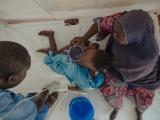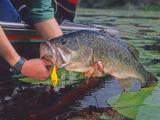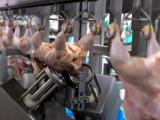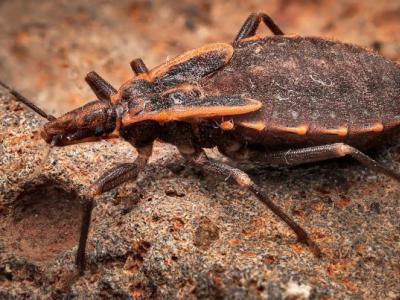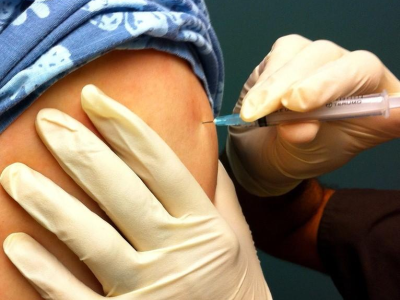Feb 16, 2004 (CIDRAP News) – The recent prediction from a panel of experts that the United States is likely to see more cases of bovine spongiform encephalopathy (BSE) does not clash with a previous Harvard University study that described a low risk of the disease, according to a member of the panel.
Will Hueston, DVM, PhD, director of the University of Minnesota Center for Animal Health and Food Safety, served on a five-member committee that reviewed the US Department of Agriculture's (USDA's) response to the BSE case that was revealed Dec 23. In a report released Feb 4, the panel said the United States probably has other undetected BSE cases stemming from infected cattle that were imported from Canada or Europe and rendered into feed for other cattle. The panel, chaired by Ulrich Kihm of Switzerland, served as a subcommittee to a USDA committee on foreign animal diseases.
"These animals have not been detected and therefore infective material has likely been rendered, fed to cattle, and amplified within the cattle population, so that cattle in the USA have also been indigenously infected," the panel's report said.
At first glance, the report seemed to contradict a widely publicized BSE risk assessment that was released by the Harvard Center for Risk Analysis in 2001 and updated in 2003. The Harvard report, commissioned by the USDA, left the general impression that there was little risk of BSE occurring in the United States.
But in an interview, Hueston pointed out that what the Harvard report actually said was that if BSE were introduced into the United States, it would spread very little and would eventually disappear, thanks to existing safeguards. "The controls in place would limit the epidemic and over time, the epidemic would extinguish itself," he said in summing up the report. "Nowhere did they say it would never occur or that it's outside the realm of possibility that there would be domestic cases."
Hueston said many people interpreted the review panel's report as contradicting the Harvard report. The Harvard authors concluded that the existing BSE safeguards in the United States are "sufficient to keep the disease from becoming an epidemic like Great Britain's," Hueston said. "At the same time they said there was a possibility for additional cases if BSE entered. I have not to date identified any major conflict between the two."
The executive summary of the Harvard report states, "BSE is extremely unlikely to become established in the U.S. For example, in a hypothetical scenario in which ten cattle infected with BSE are imported into the U.S., on average only three new cases of BSE would occur. Moreover, the disease is virtually certain to be eliminated from the country within 20 years after its introduction."
Hueston said the USDA panel and the Harvard report also agree on a key recommendation for preventing BSE: banning specified-risk materials (SRM)—high-risk tissues such as the brain and spinal cord of older cattle—from animal feed, including pet food. He noted that the Harvard report also recommended banning SRM from the human food supply, a step the USDA took shortly after the first BSE case was revealed in December.
Changing SRM ban to cover younger cattle
The USDA review panel also recommended that the definition of SRM be changed to include younger cattle—but only if increased BSE surveillance shows that the nation has more than a "minimal" risk of BSE by the standards of the World Organization for Animal Health (OIE). Hueston said many press reports of the panel's recommendations—including a CIDRAP News story—missed the conditional nature of the recommendation.
The review panel wrote that unless "aggressive surveillance" shows the risk of BSE to be minimal, the definition of SRM should be changed to include the brain, spinal cord, skull, and vertebral column of all cattle over 1 year old, plus the complete intestine of all cattle. The USDA currently defines SRM to include the brain, spinal cord, skull, vertebral column, trigeminal ganglia, and dorsal root ganglia of cattle over 30 months old, plus the small intestine of all cattle.
Until the level of BSE risk is better understood, the panel said, the current SRM ban is a "reasonable temporary compromise." Hueston said that a "minimal" BSE risk as defined by the OIE essentially means at least one case in the past 7 years, but less than one case per million cattle over 2 years old in each of the last 4 years.
To assess the level of BSE risk, the review panel called for increased BSE surveillance. The key recommendation is a 1-year program involving the testing of all cattle older than 30 months that die on the farm or during transport, all downer (nonambulatory) cattle, and all cattle showing signs suggestive of BSE. The group stopped short of recommending testing of all cattle intended for human consumption, but it did call for testing of a random sample of healthy slaughter cattle over 30 months old.
In response to the BSE case, the USDA banned downer cattle from the food supply. Hueston commented, "One challenge is when you ban downers, farmers may try to send animals to slaughter if they think they're going down in the near future. Testing of healthy slaughter cattle would help assure those animals weren't missed by the surveillance."
Reason for broadening feed ban
Another recommendation of the review panel was to ban all mammalian and poultry protein from cattle feed. The current feed rule, enacted in 1997, bans ruminant material in feed for cattle and other ruminants (cud-chewing animals such as cattle, sheep, and goats); the ban does not exclude protein from nonruminants such as pigs, horses, and poultry. Hueston said the main reason for the recommendation is the practical problem of enforcement, not any BSE risk associated with nonruminant material as such.
A completely effective ban on ruminant protein in feed for cattle would be sufficient to prevent the BSE agent from spreading through feed, Hueston said. But the broader ban is needed because of the risk of cross-contamination and the difficulty of distinguishing ruminant proteins from other proteins, he explained. If feeds for cattle and nonruminants are made in the same mill, the concern is that nonruminant feed containing cattle parts could accidentally get mixed into cattle feed.
"Scientifically, if we ban ruminant to ruminant [feed], we're OK," Hueston said. "But based on our experience in other countries, we have to be concerned about cross-contamination. And we have to have an aggressive compliance mechanism in place to make sure it's working—and right now we don't have good diagnostic tests."
How many BSE cases?
The review panel didn't predict how many other BSE cases might turn up, and Hueston said, "I can't really estimate what those numbers might be. In the past I've said I won' t be surprised if there are two or three more diagnoses. The exposure was undoubtedly greater than the two cases that have been identified [one in Canada and one in the United States]. With feed exposure there would've been groups of animals exposed."
The most likely BSE transmission scenario, he said, is that some infected cattle were imported into Canada from the United Kingdom and were rendered into cattle feed before Canada and the United States adopted ruminant-to-ruminant feed bans in 1997. The agent probably was amplified and spread because of the integration of the US and Canadian cattle industries. It's possible that BSE cases were introduced after the 1997 feed ban through noncompliance or cross-contamination, "but the exposure of greatest concern occurred prior to the ban," he said.


